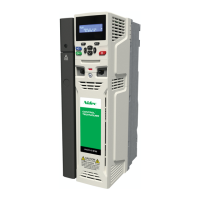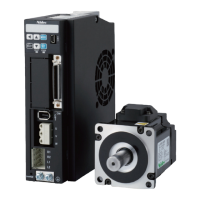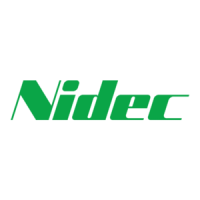
Do you have a question about the Nidec Unidrive M700 and is the answer not in the manual?
| Control Modes | Speed, Torque, Position |
|---|---|
| Cooling Method | Air-cooled, Liquid-cooled |
| Control Method | Vector control |
| Communication Protocols | Ethernet/IP, PROFINET, PROFIBUS, EtherCAT, CANopen, Modbus TCP/RTU, RS485 |
| Protection Rating | IP20 |
| Overload | 150% for 60 seconds |
| Feedback | Incremental encoder, resolver |
| Safety | STO (Safe Torque Off) |
| Protection Features | Overvoltage, Undervoltage, Overcurrent, Overtemperature, Short-circuit |
| Operating Temperature | -10°C to +50 °C |
| Storage Temperature | -40°C to +70°C |
| Humidity | Up to 95% relative humidity, non-condensing |
Information essential for avoiding safety hazards or risks of damage to products.
General safety information, hazards associated with electrical drives, and installer competence.
Information on potential electrical shock and burn hazards from drive voltages and components.
Consideration of hazards from drive functions, incorrect operation, and risk analysis for safety.
Instructions for EMC environments; installer's responsibility for compliance with legislation.
Covers SI-Ethernet option module and onboard factory Ethernet interface for Unidrive M drives.
Overview of SI-Ethernet and onboard Ethernet interface functionality.
How to identify the SI-Ethernet module using labels and color coding.
Explanation of parameter notation (S.mm.ppp) and how menus are organized.
Details of SI-Ethernet module connections, LEDs, and grounding tag.
Recommendations for reliable Ethernet cabling, routing, and double insulation.
Connecting the SI-Ethernet module grounding tag for noise immunity.
Recommendations for cable specification (CAT5e) and benefits of STP/fiber optic.
Support for multiple network topologies like Star, Line, and Tree for robust design.
Considerations for industrial Ethernet network design, topology, and data traffic to avoid problems.
Explanation of IP address and subnet mask for network connection and device location.
Points to consider when selecting addresses: reserve space, uniqueness, avoiding reserved addresses.
IP address grouping into classes (A, B, C, D, E) with specific addresses and usage situations.
A complete IP address requires both IP address and subnet mask for TCP/IP communication.
Considerations for using DHCP for automatic IP configuration.
Routing required for communication between subnets, using a router or gateway.
A flowchart detailing the steps for setting up the Ethernet interface and network connections.
Detailed descriptions of all parameters available in the Ethernet interface.
Details of Menu 0 parameters for module setup, including Module ID and Software Version.
Parameters for configuring Ethernet settings, including IP address and subnet mask.
Parameters related to Ethernet resources like cyclic links and PCB temperature.
Parameters for configuring transmit (Tx) and receive (Rx) cyclic links in Easy Mode.
Parameters for configuring synchronization settings, including Preferred Sync Master and PTP.
Parameters for configuring Modbus master and slave functionality.
Parameters for configuring EtherNet/IP protocol, including assembly objects and RPI timeout.
Parameters for defining source parameters for data transmitted to the PLC in EtherNet/IP.
Parameters for defining destination parameters for data transmitted from the PLC in EtherNet/IP.
Parameters defining values sent to mapped output destinations for fault conditions.
Configuring gateway addresses for communication between different subnets of PC/PLC and Ethernet interface.
Overview of Modbus TCP/IP protocol, its functionality, simplicity, and Ethernet flexibility.
Modbus TCP/IP data access via master requests and slave responses, handling errors.
Accessing 32-bit parameters requires contiguous 16-bit registers and specific schemes.
Explanation of Modbus register addressing modes (standard and modified) and parameter access.
Function code for reading contiguous arrays of 16-bit or 32-bit parameters.
Function code for writing a single 16-bit value to a register.
Function code for writing contiguous registers, supporting 16-bit and 32-bit parameters.
Function code for reading and writing contiguous register arrays in a single transaction.
Communication protocol for real-time motion, supporting synchronization and data transfer.
Checking message loading for each device to ensure it doesn't exceed recommended values.
Fundamental ways of sharing data: Cyclic and Non-cyclic data transfer.
Three main reasons for network bottlenecks: device overload, parameter access limits, and bandwidth.
Cyclic messages can be synchronized or non-synchronized; synchronous links use IEEE1588 clock.
Guidelines for synchronous cyclic data networks, including limiting daisy chains and segregating networks.
Sensible network segregation using VLANs and gateways for reliability with synchronous links.
Requirement for one device to be a synchronous master; disabling drive from becoming master.
Configuring cyclic links (transmit/receive) with unique link numbers, start parameters, and message types.
Enabling VLANs for synchronous links to provide priority to synchronous cyclic data.
Sending cyclic data and using it on the transmitting device with synchronous links and local receive configuration.
Exchange rate of parameters over the network, differing for synchronous/non-synchronous links.
Non-cyclic messaging for reading/writing parameters via assembly objects.
Setting destination IP address parameters, where each parameter contains two octets.
Setting destination slot and menu address in SMM format.
Reading parameter value from two signed 16-bit values and merging them into a 32-bit value.
Supports EtherNet/IP protocol, including assembly objects, RPI timeout, and consistency.
RPI timeout occurs on loss of cyclic data message after establishment, triggering a requested action.
Ensuring data consistency by enabling read consistency and using a trigger parameter.
Ensuring data consistency for writes by enabling write consistency and using a trigger parameter.
Configuring EtherNet/IP interface to map parameter data to assembly objects for cyclic data.
PLC configuration for cyclic communication, specifying parameter data word length and number of parameters.
Assembly objects group attributes for drive control/monitoring, accessing parameters via Control Techniques objects.
Output assembly object for basic speed control, including control word and speed reference.
Output assembly object for extended speed control, including control word and speed reference.
Output assembly object for basic speed and torque control, including control words and references.
Input assembly object for basic speed feedback, including status word and speed actual.
Input assembly object for extended speed feedback, including status word and drive states.
Input assembly object for basic speed and torque feedback, including status and actual values.
Overview of the Object Model, listing supported object classes and their effects.
Identity object provides device identification and general information, including VendorID and DeviceType.
Motor data object provides motor information (instance 1 for motor 1, instance 2 for motor 2).
Control Supervisor object accesses attributes for drive control and monitoring.
AC/DC Drive object provides information on drive running state and supports various attributes.
Unidrive M Connect is a configuration tool for commissioning, optimizing, and monitoring drives.
Machine Control Studio is a CoDeSys-based development environment for Unidrive M and MCi modules.
CTScope is an oscilloscope application for monitoring drive parameters.
SyPTPro is an integrated development suite for distributed drive applications using DPL or ladder languages.
CT OPC server facilitates SCADA/HMI connection to industrial equipment via OPC DA interface.
Importance of security in open networked systems, covering passwords, network infrastructure, and procedures.
Issues related to connecting to networks, including data flow impact and virus considerations.
Risk of transferring viruses and importance of up-to-date anti-virus software.
Use of firewalls for security between automation and business networks to restrict access.
By default, all supported protocols are available, configurable via relevant protocol menus.
Use of LEDs on Ethernet connection for diagnostics, indicating connection status and data flow.
Drive trips forced by Ethernet interface errors, indicating slot and trip code parameters.
Possible Ethernet sub trip codes displayed in Pr 0.10.070, with relevant text strings.
SlotX.HF trip codes and sub trip strings for internal hardware errors detected by the Ethernet interface.
A flowchart to help diagnose and resolve common problems encountered with the Ethernet interface.
Unique network identification for communication, used for source and destination determination.
Address uniquely identifying a node on a subnet or network.
Unique address assigned at manufacture, used for interface connection before IP assignment.
Defines IP address subnet and host parts.
Protocol allowing Modbus over TCP/IP for parameter manipulation.
Industrial application layer protocol for Ethernet communication using assembly objects.







